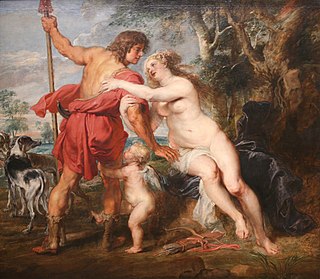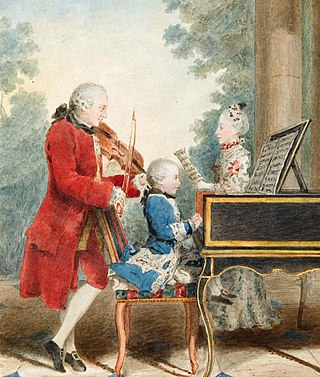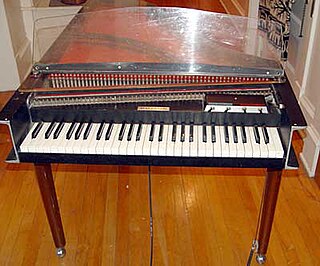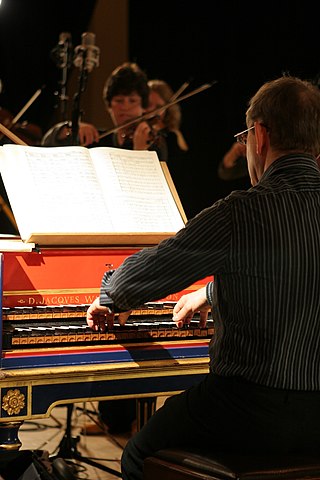The following is a list of examples of various types of Baroque architecture since its origins.
The following is a list of examples of various types of Baroque architecture since its origins.

The Baroque or Baroquism is a Western style of architecture, music, dance, painting, sculpture, poetry, and other arts that flourished from the early 17th century until the 1750s. It followed Renaissance art and Mannerism and preceded the Rococo and Neoclassical styles. It was encouraged by the Catholic Church as a means to counter the simplicity and austerity of Protestant architecture, art, and music, though Lutheran Baroque art developed in parts of Europe as well.

The Classical period was an era of classical music between roughly 1750 and 1820.

Early music generally comprises Medieval music (500–1400) and Renaissance music (1400–1600), but can also include Baroque music (1600–1750). Originating in Europe, early music is a broad musical era for the beginning of Western classical music.

Baroque architecture is a highly decorative and theatrical style which appeared in Italy in the early 17th century and gradually spread across Europe. It was originally introduced by the Catholic Church, particularly by the Jesuits, as a means to combat the Reformation and the Protestant church with a new architecture that inspired surprise and awe. It reached its peak in the High Baroque (1625–1675), when it was used in churches and palaces in Italy, Spain, Portugal, France, Bavaria and Austria. In the Late Baroque period (1675–1750), it reached as far as Russia, the Ottoman Empire and the Spanish and Portuguese colonies in Latin America. In about 1730, an even more elaborately decorative variant called Rococo appeared and flourished in Central Europe.

The following lists of violinists are available:
A Baroque orchestra is an ensemble for mixed instruments that existed during the Baroque era of Western Classical music, commonly identified as 1600–1750. Baroque orchestras are typically much smaller, in terms of the number of performers, than their Romantic-era counterparts. Baroque orchestras originated in France where Jean-Baptiste Lully added the newly re-designed hautbois (oboe) and transverse flutes to his orchestra, Les Vingt-quatre Violons du Roi. As well as violins and woodwinds, baroque orchestras often contained basso continuo instruments such as the theorbo, the lute, the harpsichord and the pipe organ.

Congonhas is a historical Brazilian city located in the state of Minas Gerais. It is situated 90 kilometres (56 mi) south from Belo Horizonte, the capital of state of Minas Gerais, by the highway BR-040. As of 2020, the city had a population of 55,309.

Ukrainian Baroque, or Cossack Baroque or Mazepa Baroque, is an architectural style that was widespread in the Ukrainian lands in the 17th and 18th centuries. It was the result of a combination of local architectural traditions and European Baroque.

Baroque pop is a fusion genre that combines rock music with particular elements of classical music. It emerged in the mid 1960s as artists pursued a majestic, orchestral sound and is identifiable for its appropriation of Baroque compositional styles and dramatic or melancholic gestures. Harpsichords figure prominently, while oboes, French horns, and string quartets are also common.

A harpsichordist is a person who plays the harpsichord. Harpsichordists may play as soloists, as accompanists, as chamber musicians, or as members of an orchestra, or some combination of these roles. Solo harpsichordists may play unaccompanied sonatas for harpsichord or concertos accompanied by orchestra. Accompanist harpsichordists might accompany singers or instrumentalists, either playing works written for a voice and harpsichord or an orchestral reduction of the orchestra parts. Chamber musician harpsichordists could play in small groups of instrumentalists, such as a quartet or quintet. Baroque-style orchestras and opera pit orchestras typically have a harpsichordist to play the chords in the basso continuo part.

Frederiksberg Palace is a Baroque residence, located in Frederiksberg, Denmark, adjacent to the Copenhagen Zoo. It commands a view over Frederiksberg Gardens, originally designed as a palace garden in the Baroque style. Constructed and extended from 1699 to 1735, the palace served as the royal family’s summer residence until the mid-19th century. Since 1869, it has housed the Royal Danish Military Academy.

The Baroque Revival, also known as Neo-Baroque, was an architectural style of the late 19th and early 20th centuries. The term is used to describe architecture and architectural sculptures which display important aspects of Baroque style, but are not of the original Baroque period. Elements of the Baroque architectural tradition were an essential part of the curriculum of the École des Beaux-Arts in Paris, the pre-eminent school of architecture in the second half of the 19th century, and are integral to the Beaux-Arts architecture it engendered both in France and abroad. An ebullient sense of European imperialism encouraged an official architecture to reflect it in Britain and France, and in Germany and Italy the Baroque Revival expressed pride in the new power of the unified state.

The Clérigos Church is a Baroque church in the city of Porto, in Portugal. Its 75-meter-tall bell tower, the Torre dos Clérigos, can be seen from various points of the city and is one of its most characteristic symbols.

The Baroque Churches of the Philippines are a collection of four Spanish Colonial-era baroque churches in the Philippines, which were included in UNESCO's World Heritage List in 1993. The churches are also considered as national cultural treasures of the country.

Edwardian architecture usually means a Neo-Baroque architectural style that was popular for public buildings in the British Empire during the Edwardian era (1901–1910). Architecture up to the year 1914 may also be included in this style.

Baroque music refers to the period or dominant style of Western classical music composed from about 1600 to 1750. The Baroque style followed the Renaissance period, and was followed in turn by the Classical period after a short transition. The Baroque period is divided into three major phases: early, middle, and late. Overlapping in time, they are conventionally dated from 1580 to 1650, from 1630 to 1700, and from 1680 to 1750. Baroque music forms a major portion of the "classical music" canon, and is widely studied, performed, and listened to. The term "baroque" comes from the Portuguese word barroco, meaning "misshapen pearl". The works of Antonio Vivaldi, George Frideric Handel and Johann Sebastian Bach are considered the pinnacle of the Baroque period. Other key composers of the Baroque era include Claudio Monteverdi, Domenico Scarlatti, Alessandro Scarlatti, Alessandro Stradella, Tomaso Albinoni, Johann Pachelbel, Henry Purcell, Georg Philipp Telemann, Jean-Baptiste Lully, Jean-Philippe Rameau, Marc-Antoine Charpentier, Arcangelo Corelli, François Couperin, Johann Hermann Schein, Heinrich Schütz, Samuel Scheidt, Dieterich Buxtehude, Gaspar Sanz, José de Nebra, Antonio Soler, Carlos Seixas and others.

Early music festivals is a generic term for musical festivals focused on music before Beethoven, or including historically informed performance of later works. The increase in the number of music festivals specializing in early music is a reflection of the early music revival of the 1970s and 1980s. Many larger festivals such as that an Aix-en-Provence Festival also include early music sections, as do, inevitably, festivals of sacred music; such as the Festival de Música Sacra do Baixo Alentejo, in Portugal. Although most early music festivals are centered on commercial performance, many include also workshops. This articles includes an incomplete list of early music festivals, which may overlap with topics such as list of Bach festivals, list of maritime music festivals, list of opera festivals, and in some cases list of folk festivals.

Czech Baroque architecture refers to the architectural period of the 17th and 18th century in Bohemia, Moravia and Czech Silesia, which comprised the Crown of Bohemia and today constitute the Czech Republic.